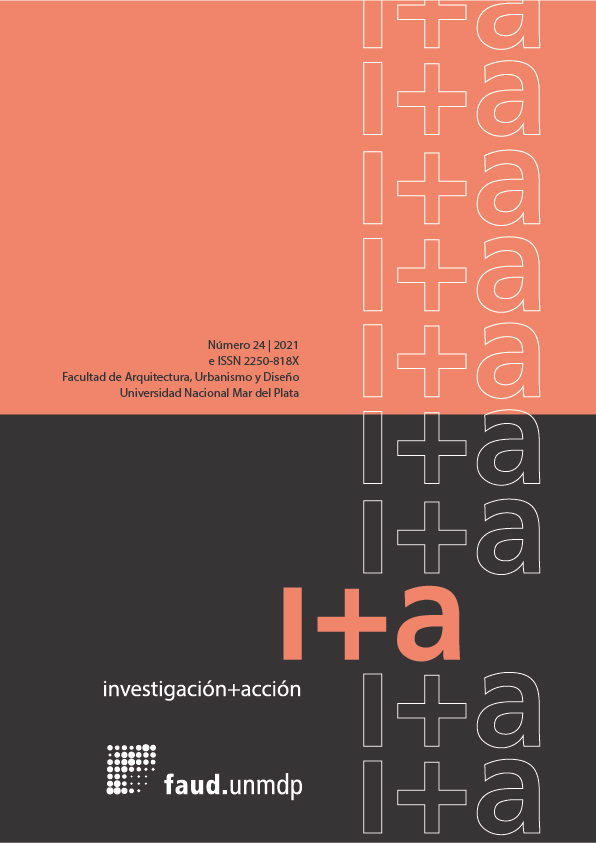THE VEGETATION IN NEIGHBORHOODS OF MAR DEL PLATA.
STUDY FROM SATELLITE IMAGES
Keywords:
urban vegetación, tree cover, NDVI, Mar del Plata neighborhoodsAbstract
Urban vegetation offers numerous benefits that improve the quality of the environment and the living conditions of the resident population, but the information obtained through satellite images is rarely transferred to a scale useful for urban environmental planning, such as neighborhoods in a city. location. In this context, the work determines the total tree cover for the city of Mar del Plata and then establishes a vegetation value for each neighborhood of the locality based on the Normalized Difference Vegetation Index (NDVI). The results show that trees represent 14.9% of the total area of the city, while the average NDVI is 0.179 for the entire locality, while at the same time it tends to increase from the neighborhoods of the central areas to the periphery. On the other hand, 29 neighborhoods are registered with values considered moderate and the rest have lower values. However, the cartography shows high values in some neighborhoods near the center and highlights the importance of urban forest reserves as conservation areas.
Downloads
References
Barbosa Gómez, G. A. (2015). Valorización Ambiental de la cobertura vegetal afectada según diseños previos de planificación del corredor ALO (Avenida Longitudinal del Occidente). Tesis de maestría. Universidad de los Andes. Facultad de Ingeniería, Departamento de Ingeniería Civil y Ambiental. Bogotá, Colombia.
Daga, D. Y., Zulaica, L., & Vázquez, P. (2020). El periurbano de Mar del Plata (Argentina): clasificación digital de los usos del suelo y análisis de las transformaciones en el cinturón hortícola. Revista Geográfica de América Central. Vol. 65, pp. 175-206.
Lowry, J. H., Baker, M. E., & Ramsey, R. D. (2012). Determinants of urban tree canopy in residential neighborhoods: household characteristics, urban form, and the geophysical landscape. Urban Ecosystems. Vol. 15(1), pp. 247-266.
Municipalidad de General Pueyrredón. Datos abiertos (2021). https://datos.mardelplata.gob.ar/ (Consultado en agosto, 2021).
Nesbitt, L., Meitner, M. J., Girling, C., Sheppard, S. R., & Lu, Y. (2019). Who has access to urban vegetation? A spatial analysis of distributional green equity in 10 US cities. Landscape and Urban Planning, Vol. 181, pp. 51-79.
Nowak D., Dwyer J., Childs G. (1998). Los beneficios y los costos del enverdecimiento urbano. En Krishnamurthi L, Rente Nascimento J (Eds.) Áreas verdes Urbanas en Latinoamérica y el Caribe (pp. 17-38). Ciudad de México: Editorial Universidad Autónoma de Chapingo.
Parmehr, E. G., Amati, M., Taylor, E. J., & Livesley, S. J. (2016). Estimation of urban tree canopy cover using random point sampling and remote sensing methods. Urban Forestry & Urban Greening. Vol. 20, pp. 160-171.
Pinheiro, M. A., & Silva, J. M. O. (2019). Análise da temperatura de superfície e a Relação Com o Ndvi da zona urbana do Município Do Crato/Ceará 2017. Revista da Casa da Geografia de Sobral (RCGS). Vol. 21(2), pp. 334-347.
Schwarz, K., Fragkias, M., Boone, C. G., Zhou, W., McHale, M., Grove, J. M., ... & Cadenasso, M. L. (2015). Trees grow on money: urban tree canopy cover and environmental justice. PloS one, Vol. 10(4), e0122051.
Soto, M. (2010). Revisión de los modelos CITYgreen, i-Tree Tools ECO e i-Tree Tools Streets, como herramientas para la cuantificación de los servicios ecosistémicos prestados por el arbolado urbano de Bogotá. (Tesis de grado). Pontificia Universidad Javeriana - Facultad de Estudios Ambientales y Rurales. Bogotá, Colombia.
Soto-Estrada, E. (2019). Estimation of the urban heat island in Medellin, Colombia. Revista internacional de contaminación ambiental. Vol. 35(2), pp. 421-434.
USDA Forest Service. (2021) https://www.itreetools.org (Consultado en agosto, 2021).
USGS. (2021). NDVI, The Foundation for Remote Sensing Phenology
https://www.usgs.gov/core-science-systems/eros/phenology/science/ndvi-foundation-remote-sensing-phenology?qt-science_center_objects=0#qt-science_center_objects (Consultado en agosto, 2021).
Wang, R., Feng, Z., Pearce, J., Yao, Y., Li, X., & Liu, Y. (2021). The distribution of greenspace quantity and quality and their association with neighbourhood socioeconomic conditions in Guangzhou, China: A new approach using deep learning method and street view images. Sustainable Cities and Society. Vol. 66, 102664.
Downloads
Published
How to Cite
Issue
Section
License
Copyright (c) 2021 Investigación + Acción

This work is licensed under a Creative Commons Attribution 4.0 International License.
Aquellos autores/as que tengan publicaciones con esta revista, aceptan los términos siguientes:
- Los autores ceden a Revista I+A de forma gratuita y no exclusiva, los derechos de reproducción, distribución y comunicación pública de su obra, autorizando asimismo su inclusión en la revista digital; su transformación, siempre que sea necesaria para permitir su preservación y uso en formato electrónico, así como para la incorporación de sistemas de seguridad y/o identificación de procedencia y el almacenamiento en servidores institucionales
- La obra estará sujeta a la Licencia de reconocimiento de Creative Commons BY, que permite a terceros compartir la obra indicando su autor y su primera publicación esta revista.
- El/los autor/es podrá/n adoptar otros acuerdos de licencia no exclusiva de distribución de la versión de la obra publicada (p. ej.: depositarla en un archivo telemático institucional o publicarla en un volumen monográfico) siempre que se indique la publicación inicial en esta revista.
- Se permite y recomienda a los autores/as difundir su obra, tanto en sus sitios web personales, en repositorios institucionales o temáticos en cualquier versión: pre-print, post print o el archivo pdf publicado en la revista, respetando la licencia de uso Creative Commons Atribución 4.0 otorgada por la revista
- El/los autor/es deberá/n declarar la originalidad del material y transferir los derechos para la publicación. No se pagarán derechos de autor.





